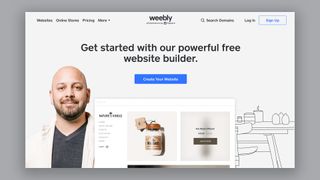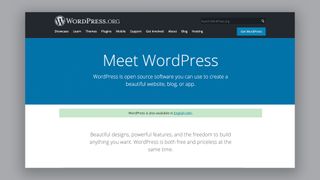Jump to the top 3↴
1. Best overall: Wix
2. Easiest: Weebly
3. Best for newsletters: Substack
4. Best for pros: WordPress.org
5. Easy WordPress: WordPress.com
6. Best for coders: Joomla
How to choose
How we test
FAQs
The best free blog websites can help you to promote your work to a wider audience without the cost associated with opting for a full-blown website of your own and without needing to know anything about coding. And free doesn’t have to been inferior. We’ve tested a wide range of options, and we think some of the best free blog sites are even as good as some paid-for platforms.
We’ve reviewed each of the free blogging platforms below for ease of use, versatility, performance and design. We also took feedback from other creatives who have used them to get a better idea of how good they are long term.
If you’re a newbie, see our guide to how to start a blog, and if you’d rather create a fuller site, see our guide to the best website builder. In the meantime, here’s our pick of the best free blog sites, starting with our top 3 picks.
Top 3 picks
1. Wix: The best free blog website platform overall
We found Wix very easy to use to start a blog for free. You can do everything with simple templates, so you don’t need to know anything about coding. You can remove the ads and get a personalised URL from just £3/$3.54 a month.
Read more below
2. Weebly: the best free blog website for beginners
We find Weebly even easier to use than Wix. That makes it a great choice for artists and designers who are tech-challenged or new to blogging. The free plan comes with hosting included, while paid-for plans start from £4/$6.
Read more below
3. Substack: the best free blog platform for newsletters
Want to promote your art or design business via an email newsletter and a blog? Substack lets you do both. In our review, we found its editorial interface super-intuitive, and it’s free till you take on paying subscribers.
Read more below
The best free blog websites in full
Why you can trust Creative Bloq
Our expert reviewers spend hours testing and comparing products and services so you can choose the best for you. Find out more about how we test.
The best free blog website overall

Reasons to buy
Reasons to avoid
✅ You want a good range of features for free: We think Wix provides the best range of free features for those that want to get going quickly, including a good range of templates, 500MB of storage and 1GB of bandwidth.
❌ You want to design your blog just how you want it: Wix provides loads of templates, but it’s not as flexible as creating your own site with WordPress. You’re also stuck with a Wix URL on the free plan.
🔎 Wix provides the best balance of the platforms we tested for ease-of-use, flexibility and value. Customisation is limited, and you may eventually want to pay for your own URL, but the options are plentiful. ★★★★
Need to launch a blog quickly and easily? We think Wix is the best free blogging platform for most people who want to get up and running quickly, with a good range of design options to choose from, for free.
Design and usability: This popular blogging platform lets you build a blog (or any other kind of website for that matter) using a simple drag and drop interface. When we reviewed it, we found getting started and using the interface to be incredibly straightforward. We were also quite impressed with the range of templates to choose from, and the fact that you get 500MB of online storage and 1GB of bandwidth, all for free. For these reasons, Wix attracts a lot of artists and designers, even if it isn’t aimed at them specifically.
Pricing: Note that the free account is quite limited. You’ll also have an ad for Wix on your site and a Wix domain name. You’ll have to pay to remove those and unlock features like an online store and Google Analytics, but the paid-for plans are reasonably priced. We’d suggest starting with the free plan and then upgrading once you begin to attract visitors and want to make things look more professional.
Read more: Wix review
| Attributes | Notes | Rating |
|---|---|---|
| Interface and usability | Easy-to-use drag-and-drop approach. | ★★★★★ |
| Versatility | Fairly versatile, with a decent amount of bandwidth. | ★★★★★ |
| Pricing | Limited free plan | ★★★★ |
The easiest free blog website

Reasons to buy
Reasons to avoid
✅ You want a super simple interface: Weebly makes setting up a blog as simple as possible.
❌ You want more customisation: The flipside of Weebly’s ease of use is that we found it to be a little more limited in terms of customisation options.
🔎 Weebly is our top pick if you want the least things to think about when creating a blog. It’s very similar to Wix but with fewer tools, which may make it easier to use for beginners. ★★★★
If you’re a little intimidated by the process of building a blog, we would suggest taking a look at Weebly. When we tested it out for our review, we found it even easier to use than Wix (number one on our list).
Design and usability: Weebly has a lot in common with Wix. Like the former, it also uses a drag-and-drop system, which lets you quickly create a website using a template. In our experience of testing the software, we found the main difference is that Weebly doesn’t offer as many customisation options as Wix. But the positive side of that is that the interface is less cluttered and easier to use – perfect for a free blogging platform.
Pricing: As with Wix, the free plan means a Weebly ad on your site and a branded domain name. You also get access to customisable layouts, several free themes, and social sharing features. With a paid plan, you’ll lose the ads, get a custom domain, and have more customisation options.
Read more: Weebly review
| Attributes | Notes | Rating |
|---|---|---|
| Interface and usability | Very streamlined and easy to use. | ★★★★★ |
| Versatility | Customisation options are limited, but there is a range of templates to choose from. | ★★★★ |
| Pricing | Limited free plan | ★★★★ |
The best free blog website for newsletters

Reasons to buy
Reasons to avoid
✅ You want to send newsletters: Substack’s biggest strength is its newsletter service. Using it as blog is more of a bonus.
❌ You want freedom to control how your blog looks: Customisation options are mainly limited to text formatting and embedding images and videos.
🔎 Substack is most appealing if you want to mail out your blog entries direct to subscribers’ inboxes. As a blog on its website, the design options are limited, but it will do the job if you’re not bothered about the freedom to make your blog look more unique. ★★★★★
More and more artists and designers are promoting themselves with email newsletters. For many, this is an alternative to blogging… but it needn’t be. We discovered that with Substack you can actually kill two birds with one stone. Newsletters are Substack’s main focus, but you also get a web page to share all your past newsletters in one place. So it effectively works as a free blogging platform too.
Design and usability: We should clarify that if you want a unique look for your blog, this isn’t the best choice. Since Substack’s main focus is on emails, its blog features are extremely limited. However, you will get a basic CMS (content management system) with text formatting tools and the ability to embed images, video and other web content.
When we used Substack to set up a newsletter/blog for our review, we found it to be one of the easiest interfaces we’d ever used. We particularly liked the version history feature, which lets you easily access past versions of your post, and the fact that the lightweight interface kept working even during periods of low mobile connectivity. See our full Substack review for more details.
Pricing: Substack is free as long as you make your posts/emails free for everyone to read. Only once you start charging people for subscriptions will Substack take a cut.
| Attributes | Notes | Rating |
|---|---|---|
| Interface and usability | Lightweight and intuitive CMS. | ★★★★★ |
| Versatility | Design customisation is very limited but you can send newsletters too. | ★★★ |
| Pricing | Free as long as your posts are free. | ★★★★★ |
The best free blog website for professionals

Reasons to buy
Reasons to avoid
✅ You want the freedom to design your blog however you want it: Wordpress.org is versatile website-building software that supports a huge range of tools, customisation templates and powerful plugins allowing you create a site that looks and behaves just like you want it to.
✅ You want a free site with no ads: Since WordPress.org is open source, free really means free in this case, with no ads (apart from any you might want on the site).
❌ You want to launch your blog quickly and easily: The downside of WordPress’s versatility is that it can a significant time investment to learn how to use the software itself and the many additional tools available. You’ll also have to sort out hosting and buy a domain name.
🔎 WordPress.org is a great option if you’re prepared and able to put the time in to create a more unique-looking blog with the features and functions you want the way you want them. The software is free and very versatile, but there’s a steep learning curve for beginners, and you’ll need to buy hosting. ★★★★½
With the options mentioned so far, you only get limited control over how your blog posts look. As an artist or designer, you’re probably used to having more control over your work. We think the best free blogging platform for that fine level of control is WordPress.org (not to be confused with WordPress.com).
Design and usability: WordPress.org is an open-source site-building software is totally free to use, and we’ve found that what you can do with it is basically unlimited. The pay-off is that it takes a bit more work to learn the system. But if you’re planning to be a professional blogger – to actually make a proper living from blogging, it’s worth taking the time to master it.
When we reviewed it, we found that WordPress.org’s software takes some time to understand, and getting the results you want may require learning at least some web design skills.
This isn’t, then, the best choice of free blogging platform if you want to build a blog in a day. Considering this is a self-hosted platform with no dedicated customer support, that may be a step too far for some. However, if you take the time to get to grips with it, you’ll be rewarded with an unprecedented degree of control over your site. You get to choose your domain name. Plus, any ads that appear on your blog will be ones that you’ve chosen to put there.
Pricing: WordPress.org is free and open source, so you pay nothing at all to create your blog. However, bear in mind that you will still need to pay for web hosting and a domain name to get your blog online.
Read more: WordPress.org review. Also check out our guides to the best free WordPress themes and best WordPress plugins.
Our article on how to make a website will help get you started with an option like this, but you’ll also need to acquaint yourself with WordPress’s extensive documentation (our guide to the best WordPress tutorials can help).
| Attributes | Notes | Rating |
|---|---|---|
| Interface and usability | The range of options makes for a relatively steep learning curve. | ★★★★ |
| Versatility | Almost infinite options to customise your site. | ★★★★★ |
| Pricing | Free (although you’ll need to buy hosting and a domain name). | ★★★★★ |
The best free blog website platform for easy WordPress

Reasons to buy
Reasons to avoid
✅ You want the flexibility of WordPress with a helping hand: Wordpress.com is an all-in-one solution that takes some of the legwork out of getting a blog up and running.
❌ You want your own domain name: You can use your own domain name and remove ads using WordPress.com, but you’ll have to pay for that.
🔎 WordPress.com is much more versatile than the likes of Wix and Weebly, and you can get online for free if you’re happy with ads and a WordPress URL. Paid plans are good value too. ★★★½
Despite their similar names, WordPress.org above and WordPress.com are quite different beasts. The former offers a powerful web design platform but has a big learning curve and you have to pay for hosting and a domain name. In contrast, WordPress.com is an all-in-one solution, which includes hosting and a domain, and it’s much easier to use.
Design and usability: For those reasons, we find WordPress.com to be a better choice if you don’t want to spend a lot of time reading documentation and developing web design skills. When we reviewed WordPress.com, we found it offered a good selection of themes, and was much easier to set up and use than WordPress.org. On the downside, we also found the interface noticeably more complex than other free blog sites such as Wix, Weebly, and Squarespace.
Pricing: With the free plan you get free hosting, 1GB of space and a branded domain name ending in .wordpress.com. You won’t, however, have much ability to customise your site’s look and feel, and your blog will have third-party ads. You’ll have to pay for at least the Start plan at $4 a month to get rid of the ads and use your own domain name.
Read more: WordPress.com review.
| Attributes | Notes | Rating |
|---|---|---|
| Interface and usability | More complex that simple web builders like Wix. | ★★★★ |
| Versatility | Allows lots of customisation. | ★★★★ |
| Pricing | You’ll need to pay if you want your own URL or to remove ads. | ★★★★ |
The best free blog website platform for coders

Reasons to buy
Reasons to avoid
✅ You want the flexibility to create a more bespoke and complex site: Joomla allows a lot of customisation, particularly if you can code yourself.
❌ You don’t know how to code: There are quicker and easier ways to get online if you only need a simply site
🔎 Joomla is well worth considering if you have some technical skills but don’t want to design a site from scratch. If you know how to code, it offers a considerable amount of flexibility to customise a blog the way you want. ★★★½
So far, we’ve focused on platforms where you can build a blog without knowing code. But what if you are a coder? We think Joomla may be the best free blogging platform if that’s you.
Design and usability: Joomla saves you from having to built your site from scratch, but still lets you add code to customise it. It has hundreds of templates to use and customise, and lots of extensions for adding extra features and getting your blog looking the way you want it. It doesn’t have as many themes and add-ons as WordPress.org, but we think Joomla is a bit better than you’re able to code, especially if you want a larger, more complex site. If you foresee your blog growing into something bigger that you could potentially make money from, this is probably a more scalable solution.
When we reviewed Joomla, we found it offered some excellent out-of-the-box tools, as well as a good range of extensions, and overall impressive flexibility in how your blog looks and feels. However, we didn’t feel it was suitable for anyone without technical or coding skills.
Pricing: Joomla is similar to WordPress.org (number 4 on our list) in that it’s free, open-source software for website building, but you’ll need to pay for a domain name and hosting. If you don’t want to pay for hosting, Joomla has an arrangement with SiteGround for the launch.joomla.org service, which offers basic standard publishing features of Joomla, with free hosting. This free option isn’t much use if you want an advanced website from the get-go, but it’s a great way to get started, as any blog you develop here can be upgraded later into a full-fledged self-hosted project.
Read more: Joomla review.
| Attributes | Notes | Rating |
|---|---|---|
| Interface and usability | More complex that simple web builders like Wix. | ★★★★ |
| Versatility | Allows lots of customisation. | ★★★★ |
| Pricing | You’ll need to pay if you want your own URL or to remove ads. | ★★★★ |
How to choose the best free blog website platform
The best free blog website platform for you will depend on your needs, including whether you have any knowledge of web design and coding, how long you’re able to spend working on your blog and what type of presentation you want.
When choosing between them, things to consider include ease of use, design flexibility, and the ability to ‘upgrade’ to a paid site when needed. Generally, the easiest blog platforms tend to be more restrictive in terms of how your blog will look. If you want the most design flexibility, you’ll need to be willing to flex your technical and/or coding skills.
If you have no experience of making a blog or a website before, we would recommend starting with Wix or Weebly, which both have simple interfaces and free plans that are easy to upgrade if you decide you want more personalisation. If you want to sent out newsletters, we would recommend considering Substack. Ultimately, the best way to choose the right free blog site for you is to test it: they’re free so you only risk your time, and spending hands-on time with the interface will help you decide if it meets your needs.
How we tested the best free blogging platforms
We’ve tried all the best known blogging platforms out for size, including the ones on this list, in order to bring you a definite guide to the best free blog website platforms available today. We put each site through its paces by testing it to create a hypothetical blog. We assessed each for ease of use, the quality of their tutorials and documentation, and what posts actually look like once you’ve made them live, on laptops, phones and tablets.
We tried out a variety of different post types, and looked for inconsistencies and omissions in terms of the types of media you can post, including file types. Finally, we’ve assessed how ‘free’ these services actually are, as well as how much potential there is to scale up your blogging operations if they prove a success.
FAQs
Can anyone write a blog?
Yes, absolutely anyone can create and write their own blog! Tens of thousands of people do so every day, and with so many free blogging platforms out there, all you need is a computer with an internet connection to do so… or even just a phone!
A related question, of course, is: will anyone read your blog? There are absolutely no guarantees on that score, and it’s entirely down to you to promote your blog.
If you don’t have an existing audience elsewhere, our advice is to get the content right first and then start to build up your audience gradually via word of mouth. If you can provide information and insight that’s unique to your blog, by focusing on a niche area that you’re passionate and knowledgeable about, there’s every reason your blog can be a success.
Which free blogging platform is best?
The best free blog website for you will largely depend on what you’re looking for. If you want to get up and running quickly, and don’t have any web design experience, we recommend Wix, as it makes it very easy to build a website and offers over 500 customisable templates.
However, if your priority is having fine control over the look and feel of your site, and you’re willing to spend time learning how the system works, we recommend WordPress.org. Finally, if you’re an experienced coder, then you’ll find Joomla or SilverStripe gives you the sophisticated tools you need to build an advanced site to your exact needs.
Do I need a website to write a blog?
Not necessarily. Just as you can write short posts on Twitter, Facebook and Instagram without having a website, there are other social networks that allow you to write long articles and post them there.
One of the most popular business networks for blogging right now is LinkedIn. As long as you’re signed up to the social network, you can publish articles on the site for free, without needing any technical skills. Just go to where you’d normally write a short post, click on the ‘Write an article’ button and follow the steps. Once you’ve written and published your article, you can share it within LinkedIn, and also on other social networks.
How do bloggers make money?
Making money blogging is kind of like making money by playing sports. In both case, very small number of people at the top of the tree are making a large amounts of money. A larger number of people make small amounts of money. And the vast majority are making no money at all.
There are many ways to make money blogging. If you can build up a large audience, then you can sell advertising on your blog. However, the rates for this are very small, so you’ll need huge visitor numbers to make this worth your while.
If your subject is niche, then a better strategy can be to create sponsored content that both resonates with your specific audience and sells a certain product or service to them. For instance, an interior design blogger might be sponsored by a high-end wallpaper company to decorate their house in said wallpaper and blog about it.
You can also potentially earn money as a blogger through ecommerce links. You write about a product, use a special link to allow readers to buy that product, and if you do, you get a cut.
Which free blogging platform is best for making money?
If you want to make money from your blog, then most free blogging platforms are going to make that difficult. Put simply, in return for providing you with a free blog, they will incorporate their own ads into your site, and you won’t get the money for any click-throughs; they will.
The big exception is WordPress.org. Because this is open source software, you will have total control over what happens on your blog, and that includes deciding to feature your own ads, for which the money will go straight to you. However, be aware that WordPress.org does have a big learning curve to use, and you will have to pay for web hosting and a domain name separately.
Does my blog need a domain name?
Most of the best free blogging platforms will give you a URL for your site, but it will be quite a clunky one that’s difficult for people to type in or remember, and will normally contain the company’s own name. If you want your blog to be taken seriously, then, you should really buy your own domain name, especially as it’ll only cost you a few dollars. You don’t necessarily need to do this at the very start, though: it’s something you can put off till further down the line when you start to build an audience.



